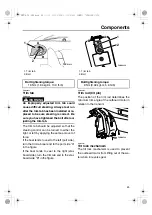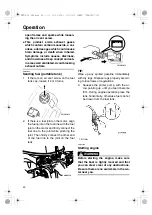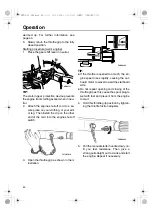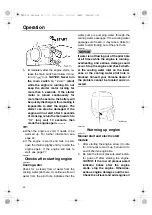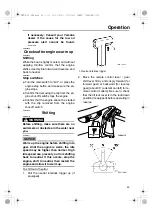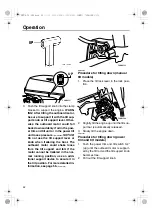
Operation
39
injury or death. Handle gasoline with
care. Never siphon gasoline by mouth.
If you should swallow some gasoline or
inhale a lot of gasoline vapor, or get
some gasoline in your eyes, see your
doctor immediately. If gasoline spills
on your skin, wash with soap and wa-
ter. If gasoline spills on your clothing,
change your clothes.
1. Be sure the engine is stopped.
2. Disconnect the fuel line from the fuel
tank and tighten the air vent screw on
the fuel tank cap.
3. Remove the portable tank from the boat.
4. Be sure you are in a well-ventilated out-
door area, either securely moored or
trailered.
5. Do not smoke and keep away from
sparks, flames, static electric discharge,
or other sources of ignition.
6. If you use a portable container to store
and dispense fuel, use only an approved
GASOLINE container.
7. Touch the fuel nozzle to the filler open-
ing or funnel to help prevent electrostatic
sparks.
8. Fill the fuel tank, but do not overfill.
WARNING! Do not overfill. Otherwise
fuel can expand and overflow if the
temperature increases.
[EWM02611]
9. Tighten the filler cap securely.
10. Wipe up any spilled gasoline immediate-
ly with dry rags. Dispose rags properly
according to local laws or regulations.
EMU27453
Operating engine
WARNING
EWM00421
Before starting the engine, make sure
that the boat is tightly moored and that
you can steer clear of any obstructions.
Be sure there are no swimmers in the
water near you.
When the air vent screw is loosened,
gasoline vapor will be released. Gaso-
line is highly flammable, and its vapors
are flammable and explosive. Refrain
from smoking, and keep away from
ZMU06598
ZMU04058
Fuel tank capacity:
25 L (6.60 US gal, 5.50 Imp.gal)
ZMU04047
6BP-9-76-1E0.book 39 ページ 2013年11月13日 水曜日 午後6時11分

